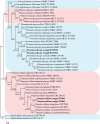Two new Cordyceps-like species, Perennicordycepszongqii sp. nov. (Polycephalomycetaceae) and Purpureocilliumzongqii sp. nov. (Ophiocordycipitaceae), in Hypocreales from karst region of China
- PMID: 39552615
- PMCID: PMC11565184
- DOI: 10.3897/mycokeys.110.135724
Two new Cordyceps-like species, Perennicordycepszongqii sp. nov. (Polycephalomycetaceae) and Purpureocilliumzongqii sp. nov. (Ophiocordycipitaceae), in Hypocreales from karst region of China
Abstract
Two new Cordyceps-like species, Perennicordycepszongqii and Purpureocilliumzongqii, isolated from a larva and soil, are introduced. Morphological comparisons and phylogenetic analyses based on multigene datasets (ITS, LSU, RPB2 and TEF) support the establishment of the new species. Moreover, new species in the families Polycephalomycetaceae and Ophiocordycipitaceae were introduced into Tiankeng and the valley for the first time. Further attention needs to be paid to the diversity of other Cordyceps-like fungi in the special eco-environment of the karst region.
Keywords: Cordyceps-like species; Ophiocordycipitaceae; Polycephalomycetaceae; morphology; phylogenetic analysis.
Wan-Hao Chen, Dan Li, Jian-Dong Liang, Xiu-Xiu Ren, Jie-Hong Zhao, Yan-Feng Han.
Conflict of interest statement
The authors have declared that no competing interests exist.
Figures



Similar articles
-
Species Diversity of Cordyceps-Like Fungi in the Tiankeng Karst Region of China.Microbiol Spectr. 2022 Oct 26;10(5):e0197522. doi: 10.1128/spectrum.01975-22. Epub 2022 Sep 12. Microbiol Spectr. 2022. PMID: 36094103 Free PMC article.
-
Chlorocilliumsinense sp. nov. (Clavicipitaceae) and Calcarisporiumguizhouense sp. nov. (Calcarisporiaceae) in Hypocreales from China.MycoKeys. 2024 Oct 2;109:91-107. doi: 10.3897/mycokeys.109.128060. eCollection 2024. MycoKeys. 2024. PMID: 39391867 Free PMC article.
-
Four new araneogenous species and a new genus in Hypocreales (Clavicipitaceae, Cordycipitaceae) from the karst region of China.MycoKeys. 2025 Jan 23;112:335-359. doi: 10.3897/mycokeys.112.140799. eCollection 2025. MycoKeys. 2025. PMID: 39897122 Free PMC article.
-
Four novel Pleurocordyceps (Polycephalomycetaceae) species from China.Front Microbiol. 2024 Jan 10;14:1256967. doi: 10.3389/fmicb.2023.1256967. eCollection 2023. Front Microbiol. 2024. PMID: 38268701 Free PMC article.
-
Cordyceps industry in China.Mycology. 2015 May 21;6(2):121-129. doi: 10.1080/21501203.2015.1043967. eCollection 2015. Mycology. 2015. PMID: 30151320 Free PMC article. Review.
References
-
- Ban S, Sakane T, Toyama K, Nakagiri A. (2009) Teleomorph–anamorph relationships and reclassification of Cordycepscuboidea and its allied species. Mycoscience 50(4): 261–272. 10.1007/S10267-008-0480-Y - DOI
-
- Ban S, Sakane T, Nakagiri A. (2015a) Three new species of Ophiocordyceps and overview of anamorph types in the genus and the family Ophiocordyceptaceae. Mycological Progress 14(1): 1017. 10.1007/s11557-014-1017-8 - DOI
-
- Ban S, Azuma Y, Sato H, Suzuki KI, Nakagiri A. (2015b) Isariatakamizusanensis is the anamorph of Cordycepsryogamimontana, warranting a new combination, Purpureocilliumtakamizusanense comb. nov. International Journal of Systematic and Evolutionary Microbiology 65(8): 2459–2465. 10.1099/ijs.0.000284 - DOI - PubMed
-
- Bátori Z, Vojtkó A, Farkas T, Szabó A, Havadtői K, Vojtkó AE, Tölgyesi C, Cseh V, Erdős L, Maák IE, Keppel G. (2017) Large-and small-scale environmental factors drive distributions of cool-adapted plants in karstic microrefugia. Annals of Botany 119(2): 301–309. 10.1093/aob/mcw233 - DOI - PMC - PubMed
LinkOut - more resources
Full Text Sources
